The Best Tree for Your Garden and Climate
The Best Tree for Your Garden and Climate!
Did you know there are around 70 different species of trees found in the UK?
Trees are not only beautiful, but they provide height, shade, and structure to any garden or garden. They also offer shelter to wildlife and contribute to healthier, cleaner air.
Still, this does not mean that every tree is automatically suitable for your property. Before you can choose the best tree for your garden, there are a few practical considerations to review first.
How much space do you have for your tree? How can you choose a tree that is visually interesting throughout the year? And how can you select trees that will be helpful to the local environment?
In this post, we will consider some of the best small trees for gardens, as well as some of the best fast-growing trees. Let us get started!
The Best Trees for Your Garden: 7 Ideas to Consider
The UK’s record-setting 44-meter beech tree may look splendid in Newtimber Hill, but it is unlikely to fit in your backyard. To help you find a more appropriately sized tree, consider one of the following species.
1. Dogwood (Cornus Florida)
If you want a compact tree that displays dazzling seasonal colours, look no further than the dogwood. These beauties put out pink or white bracts each spring, followed by bright orange and red during the autumn.
Dogwoods are perfect for small gardens or gardens since many species max out around 3m in height. Set up a few patio chairs beneath the branches to enjoy semi-shade during the summer months.
2. Weeping Willow (Salix Babylonica)
It is hard to beat the natural beauty of the delicate weeping willow tree. Their signature low branches create lovely canopies that offer lots of shade year-round.
Weeping willows do well in wet locales, which is why you will often see them beside lakes or riverbanks. They grow quickly — anywhere from 1-2.5m per year — and max out around 15m tall.
There are other varieties to consider too, including the twisted willow, goat willow, or cricket bat willow.
3. Alder (Alnus Glutinosa)
Would you like to plant a native, eco-friendly tree that will attract plenty of birds and insects? Alders are among the most popular tree species for gardens and gardens, and for a good reason.
The Alder tree features clusters of cone-like fruits during the winter and yellow catkins in the springtime. These offer an early source of nectar and pollen for bees, while many species of birds feed on the seeds.
Alders grow fairly quickly and reach a height between 18-25m when mature. They favour moist conditions, making them ideal for London gardens and gardens.
4. Blackthorn (Prunus Spinosa)
If you have ever sipped on sloe gin, you are drinking the fruits of the blackthorn tree. This thorny tree provides visual interest throughout the year and is ideal for informal hedging.
In the early spring, you will enjoy the blackthorn’s white flowers. Later in the summer, the purplish “sloes” (fruit) begin to appear. Wait until after the first frost to pick them and then make your own sloe gin at home.
Blackthorn thrives in direct sunlight and will reach a height of 6-7m. Expect to see plenty of bees, caterpillars, magpies, and other animals feeding and nesting amongst the branches.
5. Crab Apple (Malus Sylvestris)
Crab apple trees have an interesting history that experts still cannot pinpoint. It is the wild ancestor of cultivated apple trees and has long been associated with fertility and love.
One thing everyone can agree on, however, is their beauty — especially during the springtime. Crab apple trees put out stunning pink and white blossoms each spring. Birds and small mammals (such as badgers) love the fruit, while bees are drawn to the nectar and pollen.
Crab apples usually grow to a height of 7-9m, although they can be kept smaller with proper pruning.
6. Silver Birch (Betula Pendula)
There is a seemingly endless variety of birch trees to choose from, but the silver birch may be the best tree for your garden. Their distinctive silver-white bark is impossible to miss, as are its dainty, triangular-shaped leaves.
The silver birch is especially beautiful in the autumn months when the leaves turn a bright gold colour. Small birds love the birch tree for its seed and the various insects it hosts.
Expect your silver birch tree to reach a height of 15-20m when fully mature. It thrives in acidic or sandy soils, although it can tolerate moist conditions as well.
7. Japanese Maple (Acer palmatum)
Although not native to the UK, it is hard to argue the striking beauty of the Japanese maple tree. They are slow-growing and graceful, with translucent leaves that shimmer in the sunlight.
Most varieties feature a spectacular array of colours during the year, with rich reds, oranges, and purples common during the autumn. They thrive in the shade and grow well with ferns and other moisture-loving plants.
Japanese maples vary greatly in size, depending on the exact species. Dwarf maples are smaller than 1m in height, while larger varieties may reach 10m or more. If you have your heart set on a Japanese maple, you can find a varietal that will fit nicely in your garden.
Which Is the Best Tree for Your Garden?
The type of tree you plant in your garden is a big decision. After all, with proper maintenance and care, the tree will be there for many decades to come!
So then, which of the species listed above is the best tree for your garden? Use these suggestions to help you choose a tree that will complement your home and help the environment at the same time.
Now that you know the best trees for your front garden, the only thing left to do is plant them. You might be tempted to DIY, but this is a job best left to the pros.
Grafting Gardeners provides tree planting services for properties across London and Surrey. Find out more here or give us a call at 0208 123 7653 to ask us a question.
Article was written by Conner D.
Article Source: https://www.graftingardeners.co.uk/the-best-tree/
When Is the Right Time to Remove A Tree?
When Is the Right Time to Remove A Tree?
What if you had a ticking time bomb in your garden?
That is what it can feel like when deciding to remove a tree. Few homeowners know the right time to remove potentially dangerous or unwanted trees. if you wait too long, or go about removing it the wrong way, you can cause some serious damage.
So, when is the right time to remove a tree, and what is the safest way to do so?
Continue reading to discover the answers!
Threats: When to Remove a Tree Right Away
Many different factors determine when you should remove a tree. But it is arguably most important to know when you must remove unwanted trees ASAP.
Generally speaking, you should have trees removed right away if you can see that it has any upheaving roots. It is always important to remove trees that are leaning because if they should fall, this may pose a significant risk to your home.
And even if it does not look like it could hit your home, beware of trees that might pose a risk to other structures (like storage sheds or even your neighbour’s home). If the tree looks like a threat, it must be removed right away.
Remove a Tree That is Infected
We have established that you need to remove trees right away that pose a real threat. But that threat is not always as obvious as a leaning tree. Sometimes, the threat comes in the form of infection.
If you notice that a tree has some kind of infection or disease, it is important to remove it right away. Why? Because left unchecked, the afflicted tree might spread infection or disease to other trees.
The trick is to recognize these infections and diseases before it is too late. If you cannot spot something like oak wilt or emerald ash borer, then the damage may be done before you realize the tree needs to be removed.
The Best Season to Remove a Tree
We have covered the situations where you need to have a tree removed ASAP. But if the tree you want to remove isn’t diseased, infected, or posing a risk to a building, then when do you need to take it down?
If you do not mind waiting, it is generally best to remove trees during a dormant season. This is the period between late winter and early spring, and it is easier to remove trees during this time.
Why? At this point, the tree will have shed its leaves and will be much lighter and easier to move. We still recommend that you hire a professional (more on this in a bit) but removing trees during the dormant season makes the whole process easier and more efficient.
Busting a Seasonal Myth
Some homeowners are shy about hiring tree surgeons or other professionals because they want to save a bit of money. And that brings us to another major question: is there a time of year that it is always cheaper to have trees removed?
Despite popular belief, the honest answer to this question is “not really.” Typically, professionals charge you based on many factors that have little to do with the season or time of year. This includes things like the type of tree, the size of the tree, and the tree’s location.
If I wait until the dormant season will it speed up the process? Probably. But it is not necessarily going to be much (if at all) cheaper to remove a tree during winter than during summer.
Alternatives to Removing a Tree
If you are reading this, then you have got removing a tree on your mind. But it is important to figure out whether you need to remove the entire tree or simply prune it.
For example, you may want to remove a tree because unwanted branches are now hanging down and scraping your car in the driveway. But professional pruning can take care of the tree branch while still leaving the tree standing.
It is possible to do some light pruning work on your own. However, aggressive pruning can cause damage to the tree. For best results, we recommend hiring a professional tree surgeon.
You can have a tree pruned most times during the year. But you should try to avoid any pruning of a tree right after its spring growth period because this causes stress and damage to the tree.
Truly Delicate Work
When we talk about pruning a tree, you might think that this is easy and simple work. However, the entire process is more complex and more delicate than you might have previously imagined.
First, you need to have the right tools. Many homeowners do not already own proper tree-pruning tools. And if you use the wrong tools, you might end up damaging the tree.
Second, you need to understand the important differences between the trees. Some types of trees (like conifers) will need almost no pruning while others will need constant care throughout the year.
Finally, you need to understand the way different trees react to pruning and the risks this may pose. Some trees bleed sap during pruning, and this poses a potential risk of infection to the pruner as well as the tree.
Why Hire a Tree Surgeon?
We have mentioned the need to hire tree surgeons for things like pruning and tree removal. But what is it that makes hiring a tree surgeon worth it?
Such surgeons already have all of the tools and equipment they will need. By hiring their services, you save money on buying many tools of your own. And you do not have to worry about storing those tools all year round.
Tree surgeons also have the experience to do the job quickly and efficiently. And they know enough about local laws and ordinances to remove your tree in a way that does not put anyone in legal danger.
Finally, tree surgeons understand tree health. They know how to prune trees without harming them and how to remove diseased trees without endangering other trees.
Your Next Move
Now you know when to remove a tree. But do you know who can help you do it?
We specialize in tree pruning, tree removal, tree lighting, and so much more. To see what we can do about your trees, come request a free quote today!
Article was written by Conner D.
Article Source: https://www.graftingardeners.co.uk/remove-a-tree/
Tree Surgery Waste & Its Use for Biomass Fuel
Tree Surgery Waste & Its Use for Biomass Fuel
We are living in an ever-changing environment – even if the change is slow. There are various reasons behind the changes – both man-made and natural – and these are making changes that are hard for the environment to deal with.
The major issues are pollution and climate change. While many (including scientists) cannot agree with the reasons behind climate change, it is evident that we are facing a huge global challenge.
What Is Tree Surgery Waste?
Tree work waste generally belongs to one of three categories:
- Timber
- Wood chip
- Non-chippable waste (e.g., minor pruning, hedge trimmings, sweepings from the ground).
How Can Tree Surgeons Help?
Tree surgeons can adjust their practices to adopt which are more environmentally friendly. One of the ways they can do this is by turning the ‘green waste’ they produce into fuel.
How Can Green Waste Be Fuel?
For trees to grow, they use carbon dioxide (CO2). Carbon gets used in the tree’s structure during growth. It is locked up into the molecules that build the tissues of the plant, for example in cellulose. When the tree reaches felling age and becomes fuel, it re-releases its CO2 collected over the years into the atmosphere. This is then re-used again by other growing trees.
When fuel is from a sustainable source like wood, it is great for the production of something called biomass. This means that branches and logs are reduced to chippings, which are then used by power stations to generate electricity. Biomass is both clean and sustainable.
Of course, the whole process needs to have a low carbon footprint, otherwise, the whole process will be a waste of time. This means that the processes of felling, extracting, chipping, and transporting to end-users need to have low carbon footprints.
How Is Green Waste Turned into Chips?
This is a really simple process. Wood chips for power stations and small boilers must be a consistent size. The sizes can vary between 30 mm and 50 mm per chip. When burning wood chips in boilers, we also need to be mindful of the chips’ moisture content. For the boilers to be as efficient as possible, the wood chips must have a moisture content below 30%. To ‘dry out’ the wood, it is stacked up so that there is sufficient aeration.
How Does Chipping Happen?
A woodchipper or tree chipper reduces the wood to small chips. Chippers are usually portable and are mounted on frames with wheels that can be towed. Generally speaking, the power is provided by an internal-combustion engine. Usually these are between 3 and 1000 horsepower or 2.2 kW to 750 kW. Higher power chippers can be mounted on a truck with a separate engine. These usually have hydraulic cranes too.
A wood chipper usually consists of a collared hopper, a chipper mechanism and sometimes a chip collection bin. The collar helps keep unwanted items (like body parts!) away from the blades of the chipper. A tree branch is put into the hopper, goes through the chipping mechanism and the chips come out of a chute. The chips can be directed onto the floor or into a container or truck.
How Else Can Woodchips Be Used?
Aside from fuelling boilers and power stations, woodchips can be used to produce mulch for paths or gardens. For woodchips to be converted into mulch, they will be stored for a few months so that they compost. If you spread fresh mulch on gardens, it could have adverse effects on any plants growing there. This is because the bacteria that break the wood down uses nitrogen, which means this will be stripped from the soil. Allowing the wood chippings to compost before they are used to avoid this happening.
What About the Non-chippable Waste That Tree Surgery Produces?
Trimming hedges creates a huge amount of material that cannot be processed by chippers. Also, any materials that are swept up or raked can’t be chipped either because it will be contaminated with grit and soil, which can cause damage to the chipper blades. It is possible to shred non-chippable waste and this can also be used at some power stations as a biomass fuel.
What Further Work Can Tree Surgeons Do to Have a Positive Impact on The Environment?
As mentioned above, it is as important to have a low carbon footprint. Tree surgeons can process things in bulk to save energy and journeys. They can also look to sell the waste products like woodchip and mulch locally so that the carbon footprint is reduced in this way too.
What Does the Law Say with Regards to Tree Waste?
The law is quite strict regarding tree waste. In England and Wales, tree surgeons must register as a waste carrier (different rules apply to Northern Ireland and Scotland).
This rule applies if tree surgeons do any of the following:
- transport their waste.
- dispose of or transport waste for another person.
- sell or buy waste.
- act as a broker for waste (arranging someone else to handle a person’s waste).
People who do not register can be fined up to £5000.
There are also different tiers of registration too. For example, a garden landscaper or tree surgeon who is carrying green shrubs or waste they have removed is classed as being in the lower tier while carrying away construction materials would be classed as being in the upper tier.
There are exceptions, however, with mulch for example. You are allowed to store and use up to 100 tons of mulch each month. You can also store or treat up to 500 tons of waste plant matter or wood every 7 days and can keep it for 3 months. There are other exemptions too.
Tree Surgery Waste – Final Thoughts
It is great to see that so many solutions are now available for tree surgery waste. Whether chipped for biomass fuel or used as mulch, tree surgery these days can help the environment. As long as tree surgeons abide by the laws and try to keep the whole process as carbon neutral as possible, there is no reason to worry about the environmental impact of the wastes they produce.
Article was written by Conner D.
Article Source: https://www.graftingardeners.co.uk/tree-surgery-waste/
What Is a Tree Surgeon and Why You Should Hire One
What Is a Tree Surgeon and Why You Should Hire One?
Trees can live from anywhere between fifty to more than three thousand years. However, the death of a tree is inevitable.
Some owe their deaths to infestations, others owe them to diseases, and others to climate change. Now while you may think of infestations and tree diseases in the context of a forest, know that your backyard trees are not immune to disease-induced death either.
It is for this reason (among others), that timely visits from a tree surgeon are not only recommended but essential to ensure the vitality of your trees and the safety of your home.
This article takes an in-depth look into what a tree surgeon does while exploring the many benefits of hiring one.
What Does a Tree Surgeon Do?
A tree surgeon is someone who specializes in the all-round care and maintenance of trees. They are dedicated experts who plant, prune, fell, and treat trees that require special care. Additionally, they are also skilled at landscaping when larger trees are involved.
They are qualified to give you advice on how to care for and meet the daily needs of your trees. In a nutshell, they serve as your go-to expert for everything that has to do with the care of large trees.
The Benefits of Hiring a Tree Surgeon
The average person, with a fair amount of research, might be able to perform the daily care required to maintain a large tree, however, over time things can get a little more complicated.
That is where hiring a tree surgeon can help.
Eliminating Safety Hazards
Tree surgeons have the experience and the knowledge it takes to identify potential hazards. They will be able to sport the early warning signs that a tree is likely to fall during a heavy storm, or that it poses a fire hazard to your home. Furthermore, they will then be able to carry out the entire tree removal process to ensure that you and your home are protected from any preventable tree-related accidents.
Tree Care Done Right
A tree surgeon will be able to accurately assess the health of your trees and give them the care they need to thrive in their surroundings. They will give you valuable insights and advice on what you can do to improve the appearance of your trees and ensure that they lead a healthy, long, and vibrant life in your yard.
This can be especially helpful if you have a variety of trees that require different types of care. A tree surgeon will be able to give you specialized recommendations for each tree type based on the climate you live in, the type of soil you have and the nearby environment.
Spotting the Early Signs of Disease
Your trees are prone to all kinds of diseases and infestations. However, the earlier you spot the signs of tree diseases, the easier they are to treat. Ensuring frequent visits by a tree surgeon will not only allow you to take preventative measures but will also be a great way to give any infected trees the best possible treatment at the earliest signs of infection.
This will allow your trees the opportunity to make a quick recovery and will also prevent the spread of these diseases to other trees within your garden.
Trimming and Organizing
In the initial stages of growing and planting trees, it can be difficult to gauge how these saplings will eventually affect the aesthetic and landscape of your garden. However, a tree surgeon can help you plan your yard, or garden to ensure that you get the most out of your space.
Additionally, a tree surgeon is also equipped for performing various tree grooming functions like trimming, pruning, branch removal, and more. These are all essential practices required for the proper maintenance of any yard.
Advanced Tools and Other Equipment
Large trees require complicated machinery and equipment. The wrong tools can cause irreparable damage to the tree. Improper usage of equipment is a safety hazard for the person using it as well as the people around them.
While the average person does not possess the tools nor the expertise to use these tools efficiently, a tree surgeon certainly does.
Save on Future Costs
Hiring a tree surgeon will only help you save money in the long run. Proper maintenance will result in fewer instances of disease and lower the likelihood of tree-induced injuries or accidents. Due to the variety of services, they offer, they serve as an all-in-one solution to a variety of tree-related problems.
This saves you from spending on a variety of specialists. Instead, you can simply hire a tree surgeon to conduct a complete inspection of your trees and follow it up by performing the necessary maintenance procedures required. Most tree surgeons offer a variety of packages which further allow you to cut down on your costs.
Hire a Qualified Tree Surgeon for the Job
There are a host of benefits for you and your trees to gain from hiring a tree surgeon. Not only does it prolong the lives of your trees, but it ensures that you and your family are safe from any preventable tree hazards.
At Grafting Gardeners, we have the knowledge, skill, and experience to care for your trees and give them the care they need to maintain their strength and vitality through the years. Get in touch with us today to schedule an appointment with our qualified tree experts!
Article was written by Conner D.
Article Source: https://www.graftingardeners.co.uk/what-is-a-tree-surgeon/
Stump Grinding: The Process and Benefits
Stump Grinding: The Process and Benefits
Trees, along with hedges, ornamentals, and flowerbeds, make up about 18% of an average American yard. However, despite their beauty, trees do eventually naturally need to be removed every once in a while, for the safety of your home and family. This process leaves stumps around your yard that you think may not be removable, but this is not the case at all.
Tree stump grinding is a simple process that can make your yard a much more up-to-date space and remove the eyesores that are old stumps. Here, we are going to talk about what grinding is and what the process entails, so read on to learn why this process is essential for every homeowner.
What Is Tree Stump Grinding?
Tree stump grinding is the process of sanding down the stump of a tree until it no longer protrudes from the ground. This leaves a sawdust-like residue in its place but does not remove the root of the tree belowground. Its purpose is to eliminate the visual part of the stump rather than digging up the roots of the tree altogether.
The residue left behind from grinding eventually simply becomes one with the soil. This is environmentally efficient because it provides nutrition to other plants in the area. It also levels the ground out in the area where the tree once was. When you plant grass or flowers on top of this location, it will seamlessly blend in with the rest of the yard as though a tree never was there.
This process is an alternative to a full tree stump removal, which necessitates the use of extreme force to pull out the stump’s roots up from underground. Grinding is a much neater and cleaner process and uses more efficient tools and processes to eliminate the stump. This makes it less expensive for the homeowner and therefore superior in many different ways.
How Does the Process Work?
We have touched on the efficiency of the tree stump grinding process, but what exactly does stump grinding entail?
Professionals have a tool that is aptly named a ‘stump grinder.’ This tool chews away at the wood of your stump with a rotating blade. This blade is incredibly powerful and rips into the wood as it turns at top speed. The result is that tiny pieces of sawdust and mulch take the place of where the stump once was.
These stump grinders usually are handheld and therefore grinding is a precise process. The person operating it will move the blade in layers over the stump until it is ground down to below the level of the dirt. This process necessitates many safety precautions such as the wearing of goggles and other safety equipment.
In addition to handheld stump grinders, larger stumps may use those that can be attached to a truck or trailer. Rear-hitch grinders will generally not be used on residential property, nor will riding grinders that work like tractors. These are generally saved for larger applications where there are many stumps to be ground in woods or forests. You do not need to worry about these tools.
Can You DIY the Grinding Process?
While this may sound simple, it is unlikely that you have the appropriate tools to complete the process properly. You will have a terrible time getting expensively rented tools onto the site of the stump. Additionally, unless you are a trained expert in tree stump grinding, you are likely to injure yourself trying to sand it down.
Therefore, professional grinding is essential to those who need this process to be completed in their yard. This is significantly less expensive and infinitely safer than trying to do it yourself. Tree stump grinding is a serious DIY do not, so be sure that you invest in services that can get the job done appropriately.
What Are the Benefits?
There is a multitude of benefits to stump grinding, primarily that it removes an eyesore from your property. While trees make a beautiful addition to yards and gardens, stumps are ugly and take up space that can be used for other things. Eliminating these stumps through the process of grinding makes your yard look pleasing again and raises your property value.
You can also use the space created by eliminating your stump to make your yard your own. It frees up room so that you can plant a flower bed or a vegetable garden. Maintaining a garden is a fun hobby that comes with a plethora of health benefits, and eliminating your stump is the first step towards being able to garden more often.
Finally, grinding down tree stumps makes your yard a safer space for yourself and your family. Children and pets may hurt themselves by tripping over stumps in the yard while playing. They also may get splinters if they decide to play with the stump and run their fingers over it.
You may also injure yourself with the stump if you are not careful. They are a hazard when mowing your lawn and tripping over it could cause a trip to the hospital with a mower-related injury. Even if things do not go this far, they make mowing and other outdoor chores harder and more frustrating.
Get Started
Now that you know how tree stump grinding works and why it is important, it is time to begin making your property safer and more aesthetically pleasing. Contact us with any remaining questions that you may have about professional tree surgery services and how you can get our experts to your home.
We are excited to help your yard flourish and thrive in every possible way, so do not hesitate to reach out at any time.
Article was written by Conner D.
Article Source: https://www.graftingardeners.co.uk/stump-grinding/
Killing Your Trees: 6 Things You Don’t Even Realize You’re Doing to Kill Your Trees
Killing Your Trees.
Did you know that most trees live up 50-100 years on average? The famous red cedar from Alaska can live up to 3,500 years under the right environmental circumstances.
But how to care for trees in your backyard? What can you do and what you should not do to protect your beloved trees? This article discusses a few things that you should avoid when it comes to caring for your trees, so keep reading.
Killing Your Trees: 1. Putting Mulch Too Close to the Tree
Adding mulch to the base of the tree is the right thing to do, whether you have a young or mature tree. However, make sure that the mulch is not too close to the tree trunk because this might cause suffocation.
Expert gardeners recommend adding mulch approximately 6 inches away from the tree trunk. At the same time, you should keep the mulch about one foot away from the trunk of a mature tree. This ensures proper ventilation and prevents the tree trunk from suffocating during hot summer days.
Killing Your Trees: 2. Tying the Dog to Your Tree
Many homeowners have dogs in their yard. Most of these dogs live in dog houses, but sometimes you might see a dog owner tying his pet to a tree. This is done for various reasons and it might appear to be a harmless thing to do.
However, dogs will rarely just sit there and do nothing for hours on end. A dog will eventually pull and tug at the tree. In this case, the dog can cause significant damage to the tree bark. Remember that the tree bark is one of the most important defence mechanisms of a tree.
Even minor damage to the tree bark can predispose your shrub to attacks from pests. Therefore, make sure that you do not tie your dog to a tree and your dog will probably be happier too. This piece of advice is true regardless of the type or age of your tree.
Killing Your Trees: 3. Putting Concrete in Tree Cavities
This is another bad habit that could damage the health and wellbeing of your tree. In some cases, trees might develop cavities, and this can predispose them to diseases and pests. Some homeowners think that it is a good idea to pour concrete in tree cavities to fill them up and protect the tree.
This is bad because most trees will heal themselves if you give them enough time. Adding concrete is like introducing a foreign substance into your body. It can cause problems and there is no easy way to ever remove the concrete from the tree cavities in the future.
If your tree develops cavities, just make sure that you protect it against pests or wildlife animals that might cause it harm. Young trees especially will heal themselves and fill up these cavities in a few weeks under the right conditions.
4. Hammering Nails or Screws to the Tree
Homeowners might do this for various reasons. For example, some of them might try to hang bird feeders from a tree. Others pick a large tree and attempt to build a large treehouse to entertain their kids.
Although these are not bad things to do, adding nails or screws to a tree can seriously damage its health. It is like having a metal piece in your body. The nails might cut through vital areas of your tree, disrupting the flow of nutrients, slowing down the growth of a tree, and predisposing it to diseases.
Even if you try to go for smaller nails, the situation is the same. Any foreign object or substance forced inside a tree will affect its health. If you want to hang bird feeders, hang them on a sturdy branch without using nails or screws.
5. Planting Trees Around Power Lines
Electricity companies never liked the combination of power lines and trees. You never know when a storm can push the branches of a tree into the power lines and cause serious damage. On top of that, an entire street might remain without electricity and this can cause a lot of frustration and anger.
Ideally, you should keep power lines in mind when planting trees. Avoid putting a tree under an important electricity hub and try to guess how tall a tree might grow when it is fully matured. If you already have trees that are dangerously close to power lines, consider trimming their branches.
Not only branches can get entangled on power lines, but wildlife animals residing in trees can also cause problems. Adventurous squirrels can easily jump from a tree on a power line and get fried. They might cause a blackout at the same time as well.
6. Adding Salt Near the Tree
It is a common practice to add salt on the streets in winter times. This prevents skidding and slipping, especially when it snows too much, and the temperatures drop suddenly. However, salt close to your trees can be a real problem in the spring.
Keep in mind that salty soil does not allow the growth of plants, grass, and trees. A soil that has absorbed salt is virtually toxic for every organic matter. If you plan to add salt to your driveways and walkways, make sure that you avoid adding it too close to the roots of your trees.
If your local authorities are adding salt to the streets as a preventative measure, try to cover the areas surrounding your trees with a piece of cloth. This should prevent most of the salt from getting into the soil and jeopardize the wellbeing of your beloved trees.
Taking Care of Your Trees Can Raise Property Value
Yes, you read it right. Your trees are unbelievably valuable for your property and well-maintained ones can increase the value of your house. That is because they provide shade on hot summer days, improve air quality, and also add to your home’s curb appeal.
These are just a few tips on how to properly care for your trees and avoid significant damage in the long run. Make sure that you check out the other articles on our blog to learn more about different types of trees, how to care for them, and how to prolong their lifespan.
Article was written by Conner D.
Article Source: https://www.graftingardeners.co.uk/killing-your-trees/
Tree Emergencies and The Effects of Storms on Trees
Tree emergencies and how to deal with them.
Storms can affect trees in different ways. The effect is influenced by lots of factors including wind direction and speed, rain duration and intensity, location, health and age.
Trees are great at adapting to a change in conditions but this is a slow process that takes decades; they can’t adapt to a single change in weather due to a storm, of course.
Tree emergencies due to storms can take many forms. Storm damage is often different from the damage caused by floods. Of course, both can happen simultaneously.
Tree Emergencies Caused by Storms with Flooding
Lots of places around the world have natural floods annually. The shrubs and trees native to these parts have been able to adapt to prolonged periods with their roots submerged.
There are problems if non-native species are introduced in these areas because they have not adapted to being submerged in water since their native areas do not experience flooding.
When the soil is waterlogged, there is a decline in its ability to sustain life. This happens because the available air in the soil is swapped for water. This means that the roots do not have access to essential oxygen supplies.
This means that damage can happen in as little as three hours. Being submerged in water kills the tree’s fine root hairs. This means the tree’s water-absorbing ability is seriously affected. It cannot take up nutrients and water until the water level falls.
When a tree is deprived of oxygen, there is a build-up of gases that lead to the larger tree roots dying. This can affect the tree’s stability.
What’s more, flooding causes the soil’s structure to deteriorate. Particles of clay lose their stickiness, which reduces the soil’s aptitude to grip onto the roots. This means that trees are more likely to fail at the root plate level.
Floodwater also affects the pH of soils. This means that the levels of nutrients and minerals could be affected.
All in all, when soils are flooded, there is both a long-term and immediate effect on tree longevity and health. The longer the flood persists, the worse the problem.
Flood Stress Seen in Trees
Tree flood stress is not always visible immediately. It manifests itself in a variety of ways, including:
- A reduction in the size of leaves for new growth
- Yellowing of leaves (chlorosis)
- Epicormic branch and stem growths
- Crown dieback
- Lack of new leaves in spring or defoliation
- Early change of colour in autumn as well as early falling leaves
- Prolific mast or seed crop the year after the flood
Care for Flood-Stressed Trees
Caring for a tree after floods impacts on its survival chances as well as the tree quality that remains.
Here are some steps to help:
- Remove any build-up of sand or silt so that the soil is back to its normal level. Make sure you also look to cover any roots that have been exposed. This should be done with topsoil.
- Incorporate organic or composted material like mulch into the topsoil to improve its structure. Make sure you do not damage any roots. Professional tree surgeons will use something called an ‘air spade’ for this task.
- A layer of mulch or other organic, composted material will help the soil to retain its moisture. Try not to add anything like fertiliser because it uses a lot of the tree’s energy.
- Watch out for colonisation. Stressed trees often have trouble fighting off secondary organisms like insects, fungi, and bacteria.
Storms with no Flooding
When there is no flooding, the main issue with storms is the wind. Trees are susceptible to storm damage when the force of the wind exceeds the tree’s structural strength. This type of storm damage is very obvious; you will often see large parts of the tree snapped or even a whole tree uprooted.
Some storm conditions might cause less obvious damage. Limbs and stems can have fractures while remaining intact. Trees also might be uprooted partially but don’t fall over. There might be broken branches that haven’t fallen.
If the storm involved lightning, you might notice large wounds in the tree’s bark. Lightning strikes can also result in the tree’s destruction. Once subjected to a lightning strike, there is not much that can be done to help a tree.
Luckily, it is rare to see such major storm damage and proactive, expert tree management means you can reduce the risks.
Why be Proactive?
Proactive tree work is cost-effective since you can protect your trees with the highest risk and greatest value. Tree work can be scheduled and planned and will avoid those emergency call-outs (and their cost) if there is storm damage.
Unfortunately, with climate change, we are likely to see lots more unsettled and stormy weather. If we want trees to survive well, we need to make sure they’re inspected frequently and well managed.
It’s a good idea to seek comprehensive tree assessments with experienced tree surgeons and tree consultants. They will be able to advise tree owners and help them keep their trees safe as well as healthy.
According to statistics by the Health and Safety Executive (HSE), there are around 5 or 6 people killed each year in the UK due to falling branches or trees. Around 3 of these occur in a public space.
Of course, this makes the risk of being killed or struck by a tree extremely low; these numbers mean the risk is about 1 in 10 million. Despite the low level of risk, we need to consider how the public perceive the level of risk, especially if there has been a recent incident. Thus, tree owners should take great care in ensuring they look after their large trees.
Final Thoughts
While typical weather events can help to strengthen trees, excess forces or waterlogging from storms can cause problems. With consistent conditions, trees can adapt and initiate developmental changes to compensate for changing weather patterns.
Thanks to their biological engineering, they can adjust to loading, if the conditions are typical. When storms, floods, ice, or snow occur, the trees might not fare well. Extreme forces cause damage, injuries and even tree death. You can protect your trees with regular tree care by expert tree surgeons.
Article was written by Louise W.
Article Source: https://www.graftingardeners.co.uk/tree-emergencies/
Tree Pollarding 101
Tree Pollarding 101 – everything you need to know about pollarding.
If you are looking for ways to keep your landscape and trees looking their best, several key methods can make a huge impact on how your outdoor space looks.
A process called tree pollarding can help to create a lush, beautiful landscape that promotes healthy trees.
Read on to learn more about pollarding trees and what the process entails.
Tree Pollarding Defined
Most people likely have never heard of tree pollarding, but it is an important part of maintaining healthy trees. The process involves cutting young trees and shrubs to the main stem or trunk to control their height.
The plants are not cut at ground level but instead are cut much higher at an average height of around six feet. This process helps to maintain the desired height for your trees while reducing shade and giving the trees a defined silhouette.
Many people opt for tree pollarding to keep taller trees from getting in the way of phone lines or electrical wires. It is also done to trees located close to a home or place of business to reduce the risk of branches breaking and falling onto the roof.
While most typical tree pruning processes remove the lower and crossing limbs of a tree, the pollarding process is a bit different. Pollarding trees is often done when the tree is dormant rather than when it is actively growing. Doing this while a tree is still young or dormant promotes fuller, faster, and greener growth.
In addition to protecting wires, structures, and promoting better growth, tree pollarding may also reduce the risk of fungus and pests. It can also help to protect your trees from various diseases.
How to Pollard a Tree
To pollard a tree effectively, it is best to leave the job to the professionals. They will start by cutting off the central leader of the tree first, then proceed to cut all of the branches around it that are at the same height.
By cutting the top of the tree this way, it shortens the crown of the tree. The gardener will remove lower limbs and any crossing limbs to promote a thicker crown as it grows back.
The younger the tree, the faster the new growth will return, while older trees may take longer to regrow leaves and new branches. By pollarding large young deciduous trees, ensures that they sprout healthily to achieve fuller, greener, and lusher growth.
Once the procedure is complete, most trees will produce “waterspouts” at the various locations where it has been cut. These areas will produce sprouts that should be removed at least once per year or every other year. Eventually, knobs or knuckles will form at these locations and continue to regenerate each year.
The timing of tree pollarding is critical and should be performed during the tree’s dormant season. If the tree is pruned during its growing season, it can stunt the growth, remove its energy source, and inhibit the tree’s ability to re-sprout.
Most tree pollarding is done during the fall or winter months of the year when trees are losing their foliage. This is extremely important because most trees rely on their leaves to help produce energy for healthy growth during the warmer months of spring and summer. Removing sprouts and pollarding too early in the year can cause the tree to stop growing, or even worse – to perish.
A Tradition of Pollarding Trees
Tree pollarding originated in Europe centuries ago, and the original method was done to ensure that more abundant, smaller branches were produced. As a result, these smaller branches were removed and used as fuel or for making items such as woven baskets.
As the branches were consistently cut back, farmers would harvest the slender sprouts and use them as a food source for livestock. These slender sprouts were also utilized to help weave small fences and other structures.
Today, pollarding fruit trees is a popular method to ensure healthy growth. When the tree is pollarded correctly, it encourages more production of fruits for a bountiful harvest.
Many urban areas choose to pollard trees that line busy streets to help control their growth, preventing branches from falling onto power lines and roadways. Cutting trees back can keep them healthy while maintaining them at a smaller, more easily manageable size.
The difference between topping and pollarding trees is that tree pollarding produces large knuckles. These knuckles are the source of new growth each year and can help to ensure that the tree continues to grow healthy in the future. Imagine the knuckles on a tree as large scars that heal while new growth re-sprouts from dormant buds during the springtime.
Topping a tree does not lead to knuckle formation. This process cuts the entire top of the tree off, resulting in a large wound that can cause the tree to die. Ideally, pollarding fruit trees and other species is best to ensure a healthy outcome.
Pollarding: A Unique Technique
Whether you want to encourage healthy growth or remove threatening branches, tree pollarding is a wise way to go. This unique tree-pruning process will ensure that your trees look lush and beautiful for years to come.
Always consult with a professional arborist or landscaper if you are considering using tree pollarding as a method to ensure best results.
For more information about our services or to find out more, contact us today.
Article was written by Conner D.
Article Source: https://www.graftingardeners.co.uk/tree-pollarding-101/
Did you miss our previous article…
https://www.treesforeducation.com/?p=284
WHAT TO AVOID IN HIRING A TREE TRIMMER
So you’re in need for a tree service company? Our recent What to Look for in Hiring a Tree Trimmer guide is meant to highlight features of a tree contractor that are positives — aspects that you should look for in any company that you are considering working with. This article, on the other hand, is the opposite. It’s full of red flags! If any tree contractor has these features, then stop, and keep looking.
INCOMPLETE INSURANCE
People get insurance for their protection and also for others. The same goes for businesses. The first and top item on this list is to avoid tree contractors with incomplete or no insurance. What constitutes “complete” insurance? Due to the dangerous nature of the tree service industry, a combination of different insurances is needed to safely operate a company. But the two most vital ones are the following.
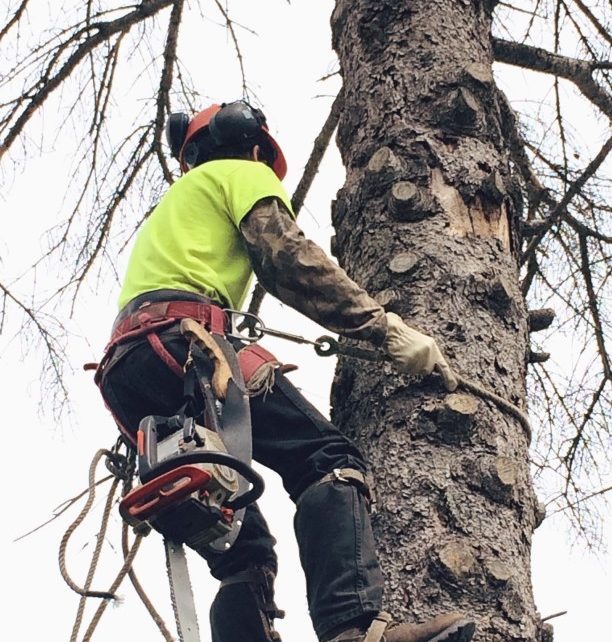 General Liability Insurance – This type of insurance is crucial for any tree service because it provides foundational business protection. It can cover property damage and bodily injury performed on jobs. Meaning, if a tree trimmer accidentally damages your roof, this is the insurance that would help with the repair. Without it, the consumer or property owner could be held liable.
General Liability Insurance – This type of insurance is crucial for any tree service because it provides foundational business protection. It can cover property damage and bodily injury performed on jobs. Meaning, if a tree trimmer accidentally damages your roof, this is the insurance that would help with the repair. Without it, the consumer or property owner could be held liable.
Worker’s Compensation Insurance – When the tree service industry is one of the most dangerous lines of work, you, as the consumer, NEED to hire a company that has worker’s comp insurance because this is what covers employee injuries. However, not all worker’s comp coverages are created equal. Worker’s compensation is extremely expensive! So, it can be very tempting for a tree service company to completely neglect it OR to classify themselves as landscapers in order to maximize their profits.
According to WorkersCompensationShop.com, the average rates in California for tree pruning employees range from 12.58-43.53%. This means that for every $100 that an employee earns, the company has to pay up to $43.53 in worker’s compensation. Just to give an idea of how significant that rate is, clerical office employees have an insurance rate of 0.36-0.99%.
Landscapers have an average insurance rate of about 11%. Due to workplace similarities, arborists may try to designate themselves as landscapers to take advantage of lower insurance rates. The difference, however, lies in the amount of coverage. Landscapers are able to perform tree work but are limited to typically 12 feet. Therefore, if a tree trimmer disguised as a “landscaper” with their insurance company gets hurt when 20 feet from the ground, their insurance will not cover the employee’s injuries. As a result, the property owner will be held liable.
UNLICENSED
Never hire an unlicensed tree service contractor! It’s a plain and simple rule.
For any tree service company, acquiring a contractor’s license with the state is a lesson that should be taught in Managing a Tree Service Company 101. As a general rule of thumb, you can expect any large or reputable tree company to already be licensed. A tree service company simply wouldn’t be able to grow to such a large status without it. However, if you come across a one-man operation, it would be a good idea to verify their license.
To learn more about why licensed tree contractors are the only way to go, please visit our What to Look for in Hiring a Tree Trimmer article for more information.
HIGHLY-DISCOUNTED COUPONS
We’ve all seen them. Coupons for 25% off! 30% off! Who doesn’t love a good coupon? And what’s not to love? Coupons work great for shaving some dollars off of a pizza order or new shoes. Those are items that typically do not cost thousands of dollars. Tree services, on the other hand, will generally cost well over $1,000.
Due to the hazardous nature of the tree service industry,  expenses are high and profit margins are low. It makes it difficult for any arborist to offer a large discount of more than 25% off. Let’s break it down. A tree company has a net profit margin of 15% (which for the arborist industry is considered to be very good). That means that after all expenses are paid, such as payroll, insurance, and gas — only 15% of revenue is left. This company quotes a customer $1,000 for a tree pruning. But wait! This particular customer has a 30% off discount coupon! That’s a whopping $300 off — leaving the business with only $700 left for wages, truck payments, gas, insurance, dump fees, etc.
expenses are high and profit margins are low. It makes it difficult for any arborist to offer a large discount of more than 25% off. Let’s break it down. A tree company has a net profit margin of 15% (which for the arborist industry is considered to be very good). That means that after all expenses are paid, such as payroll, insurance, and gas — only 15% of revenue is left. This company quotes a customer $1,000 for a tree pruning. But wait! This particular customer has a 30% off discount coupon! That’s a whopping $300 off — leaving the business with only $700 left for wages, truck payments, gas, insurance, dump fees, etc.
The only way an arborist would be able to offer such a hefty discount is if they mark up the standard market rate for a particular service in order to make up for the loss in revenue from the coupon. This is what price gouging looks like. You need your large tree trimmed. Other companies would quote roughly $2,000. But you don’t even bother getting multiple quotes because you found an awesome coupon in a local coupon book for 30% off of tree trimming services! So why look elsewhere? You’ll be saving hundreds of dollars with this coupon! This tree service company that you contacted tells you that it would normally charge $3,000 — but since your coupon shaves of 30% — your estimate now comes to $2,100. So as you see, it still falls into the same ballpark as the other companies without the coupon.
You may wonder why all of that matters? Well, what happens next time you need your tree trimmed, but you don’t have a coupon. Will they still offer you a deal? Or is their quote going to be significantly higher? Does it mean that you’ll need to spend more time again trying to figure out what tree service company to use AGAIN? Once people find a tree contractor that they like — whose work and people they trust — they tend to stick with them. Why spend all that time researching different companies and meeting with multiple estimators, when you can just go straight to the one you know?
In addition, it’s important for you to feel like you can trust your tree service company. Discounting overinflated prices is a common sales technique that many businesses use, especially in the product-based sector. It’s a pricing strategy that is effective in moving a consumer towards a purchase because they feel like they are getting a good deal — until they do a little more research and realize that their “good deal” is in line with other quotes.
POOR CUSTOMER SERVICE
The tree service industry is filled with a wide array of characters. Some companies consist of administrative personnel and field staff. And when you have your in-person estimate, you will typically be meeting with an estimator or project manager, whose job is solely customer service. So you can expect them to be professional and have strong interpersonal skills.
On the other end, some companies are a one-man show. When you have your initial visit for an estimate, you’ll be meeting with your actual tree trimmer. Tree trimmers climb trees with chainsaws and drag brush for a living. They don’t mind getting dirty and minor injuries tend to not faze. Their goal each day is to not only do a great job with the trees they’re working on, but also quite frankly— to not die! Customer service is secondary. So sometimes, you may not get the best customer experience throughout your entire journey with this particular “contractor”.
This doesn’t mean that all one-man operations provide menial customer service. Even LC Tree Service had to begin somewhere. Some of these small companies are run by great people who are highly proficient at what they do. So whether you’re dealing with a single person or a large enterprise, it’s important that you have good interactions. Do you feel that your trees are in good hands? Do you feel like your requests were heard and will be taken care of? Do you feel like you can trust the individual and the company? If you don’t, then you should look elsewhere.
LET’S SUMMARIZE
AVOID A TREE SERVICE COMPANY THAT:

LOOKING FOR A RELIABLE TREE SERVICE COMPANY?
LC TREE SERVICE WOULD BE HAPPY TO HELP!
619.677.5777
The post WHAT TO AVOID IN HIRING A TREE TRIMMER first appeared on San Diego Tree Trimmers – LC Tree Service.
Did you miss our previous article…
https://www.treesforeducation.com/?p=279
10 MOST COMMON FLOWERING TREES IN SAN DIEGO
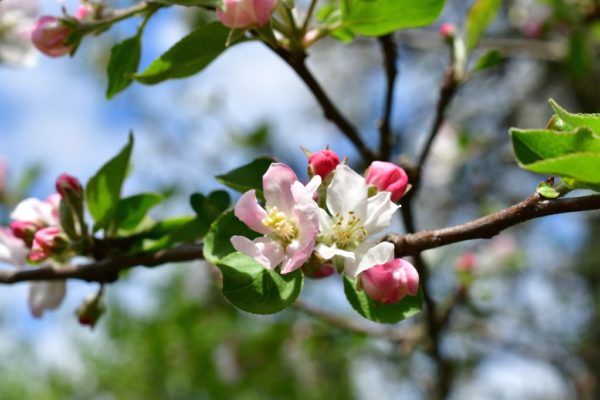


Spring season is that wonderful time of the year when colorful blooms begin to flourish throughout many parts of the world. But in the city of San Diego, we have the luxury of being able to enjoy flowering plants and trees all throughout the year due to our mild and sunny climate. In fact, many landscapers and property owners strategically plan their landscape so that there is always a flowering plant or tree from winter through autumn. As one tree’s flowering season ends, another one begins.
Whether you’re looking to add a flowering tree to your property or just plain curious, we’ve compiled a list — in no particular order of popularity — of what we consider to be the most common flowering trees in San Diego.
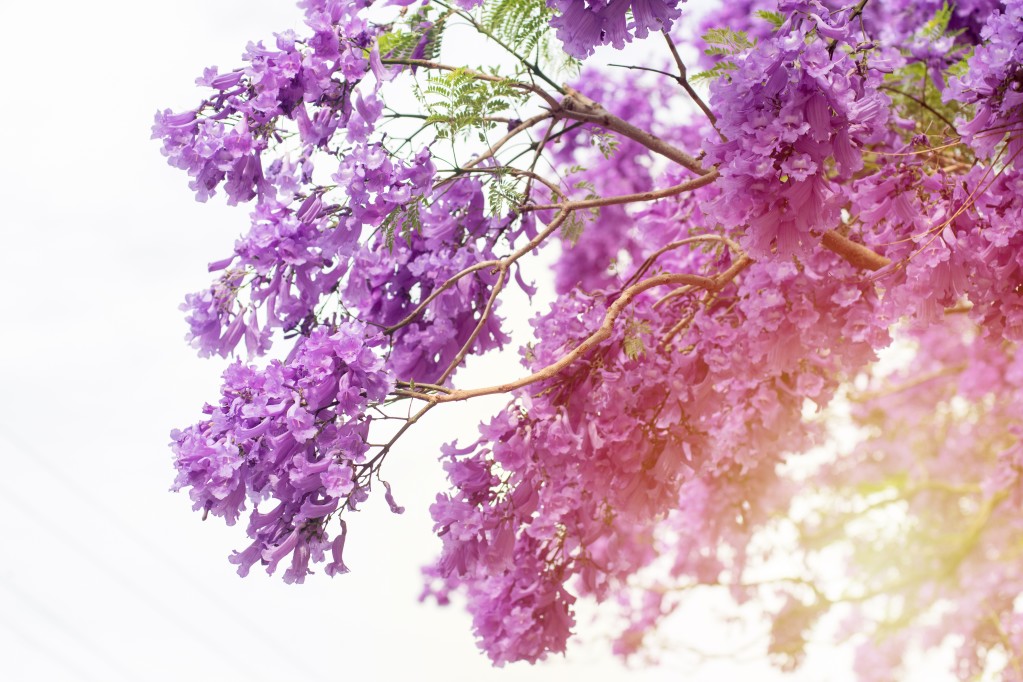

1
JACARANDA
Jacaranda mimosifolia
Jacarandas are one of San Diego’s most spectacular flowering trees. In late spring into the summer months, it’s hard to go a day driving through town without seeing at least one jacaranda and its popular lavender, bell-shaped blooms. These flowers grace us with their presence for two months before falling and creating a carpet of color on the ground beneath.
When not in bloom, the jacaranda is still one of San Diego’s finest-looking ornamental trees. Once established, it’s a fast-growing tree that develops a bright green canopy of fern leaves against the tree’s grayish-brown limbs. It grows fast, but its size at full maturity is quite manageable because it typically only grows to roughly 25 to 40 feet in height, with similar dimensions in canopy spread. The jacaranda is also a popular choice with urban planners due to its “pavement friendly” roots, which, unlike some other common trees like the ficus benjamina, is less likely to damage sidewalks and streets.
There are many wonderful features associated with the jacaranda, but even this beauty can’t be perfect in all aspects. Unfortunately, the jacaranda is a deciduous tree, which means that it loses its foliage every year. So for the winter months, you’re left with an arrangement of bending grey wood in your outdoor space. But hey…neutral colors are all the rage…so apparently it works. As the weather begins to warm up, the tree’s foliage slowly fills the canopy with yellowish-green leaves. It looks sparse and a little sickly, depending on the tree. Not very appealing, to say it nicely — but when the warmest and sunniest season arrives, the jacaranda’s beauty shines once again with its lush green canopy, followed by its magnificent purple blooms.
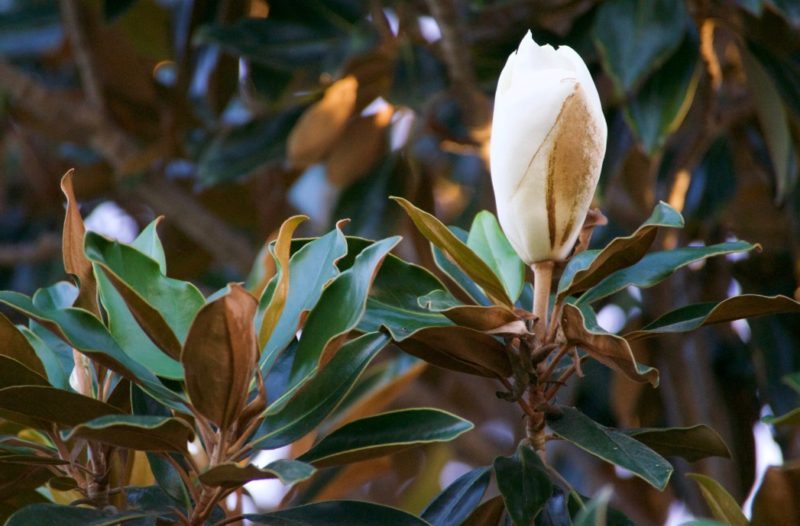
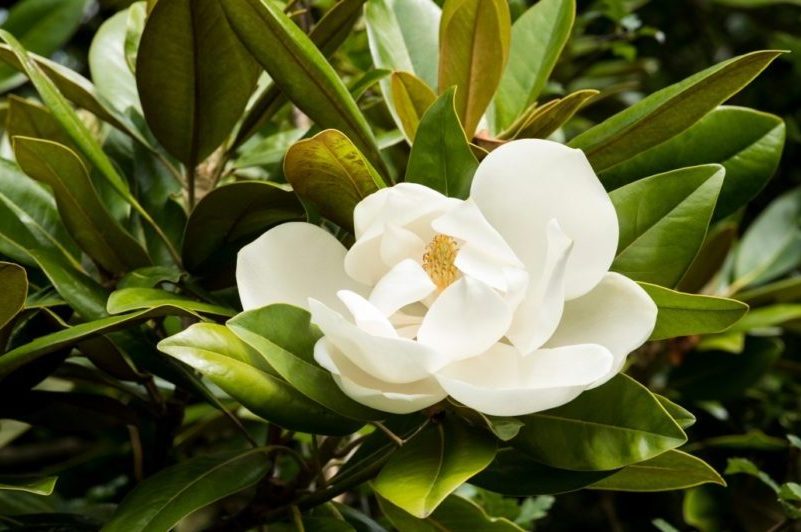
2
MAGNOLIA
Magnolia grandiflora
The magnolia tree is a very well-known name in the flowering tree category. For all you home decorators, think Joanna Gaines and her popular Magnolia Homes company. But what many do not know is that it is also the most ancient flowering plant that we know of according to fossil records. Surviving through ancient history, there are more than 200 magnolia species that originated mostly in Asia and in the Americas. They are common trees throughout the world, especially in sub-tropical and tropical regions, and are known for their stunning flower display with pink, purple, white, and even yellow blooms.
The most common magnolia in Southern California is the Southern magnolia. It possesses large evergreen leaves that exhibit a deep green color and a unique brownish touch. Then in the late spring and into the summer, the Southern magnolia unveils its beautiful, large, white flowers that contrast so well against its green foliage backdrop. When we say large, we mean large, as the oval-shaped leaves typically range from 5-8 inches in length, and its fragrant flowers possess an 8-inch diameter range.
Compared to the other popular flowering trees on this list, the Southern magnolia is a rather slow-growing tree and is known to take up to 10 years after planting to even blossom. So patience is required! But it won’t stay little forever. It typically matures to a height of 60-80 feet with a canopy spread of roughly 40 feet, and in its most ideal conditions, it even grows taller than 80 feet!
When it comes to trimming a magnolia tree, great news! They don’t require much. But the bad news is that these trees are FINICKY! Trim your tree at the wrong time of the year, and you can kiss the next year’s beautiful flower display goodbye. Even worse, given the right candidate, you could end up killing your tree. Magnolias, especially mature ones, tend to have a hard time recovering from injuries. The best time to trim them is right after its flowering season so that it has sufficient time to heal before winter. Otherwise, trimming a magnolia during the wrong season can result in excessive bleeding, which could weaken the tree and leave it vulnerable.
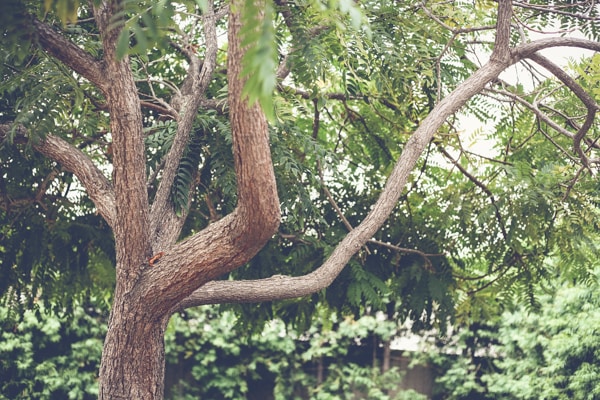
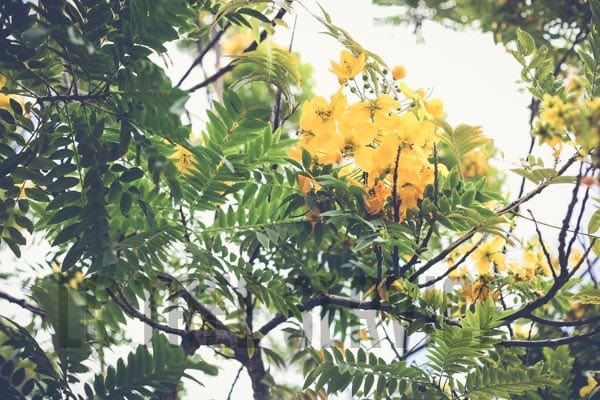
3
TIPUANA TIPU
Tipuana tipu
Native to South America, the Tipuana tipu, or tipu for short, is one of San Diego’s most popular trees. When not in bloom, it can often be mistaken for the jacaranda, since the two have very similar structures and fern-like foliage. Even arborists, at a distance, may need a moment to determine who’s who. However, once its sunny yellow flowers emerge in the spring and into the summer, there’s no mistaking the two trees.
With its roots in a tropical homeland, the tipu thrives in areas with plenty of warm sunlight, so make sure to plant it in a location with full sun. It loves the heat and can handle San Diego’s hot and dry summers extremely well. This is why it is also a popular choice for desert communities.
The tipu is a choice selection for properties and urban development throughout San Diego due to its rapid growth, pavement-friendly roots, drought resistance, and flowery display. It’s perfect for all you impatient folks who don’t want to wait 10 years for their newly-planted young tree to provide ample shade and a majestic presentation. And even better, if you’re not interested in a huge tree, the tipu is a great choice, as they are medium-sized trees that are usually seen in the 30-50ft range with a wide canopy spread that matches its height.
The Tipuana tipu is a fast-growing tree that typically grows 2-3 feet a year! A young tree has the potential to quickly develop a canopy width of 20 feet just a few years after being transplanted. Due to this rapid growth, it’s important to keep your tipu on a regular trimming schedule. Otherwise, the tree ends up looking like an unkempt child with neverending bedhead. But when properly trimmed, the tipu has the potential of looking amazing — whether it’s covered with yellow blooms or not!
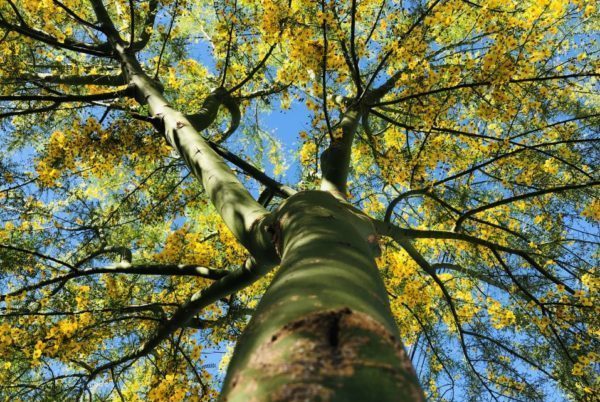

4
PALO VERDE
Parkinsonia florida, Parkinsonia microphylla, Cerdium ‘ Desert Museum’
The palo verde is another common yellow-blooming tree in San Diego. The name in Spanish means green stick because, as you can guess, it possesses limbs that are green! It’s a unique sight, especially with its yellow blooms that complement the green so well. As the palo verde matures, its trunk and mature branches eventually turn brown, but any new limbs grow out green. Why green? The bark of the palo verde is uncommonly filled with chlorophyll, which allows it to participate in photosynthesis — a job that is normally assigned to the leaves. But for this green wonder, its foliage only contributes one-third of the tree’s food.
Even with its unconventional green limbs and showy flowers that allure people, the palo verde is still one of those trees that you either love or hate. It’s actually a tree that tree trimmers can’t stand! Why? Because these trees are notorious for pain! Yes, their green branches are awesome to look at, but with close examination, you’ll realize that they’re covered with sharp spikes. It’s a desert tree, and it seems to have copied the same spiky qualities of its desert best friend (the cactus, of course). It’s like middle school cliques dressing the same. “Make sure to wear your spikes on Friday!”
As with any tree, one of the palo verde’s goals is reproduction. No harm there. However, this tree is like the “rabbit of the tree world.” Palos love to procreate, and they’re good at it. If left unmanaged, a single tree on a property can multiply into a grove of more than 20 palo verdes in less than 10 years. Also, the tree’s cute and innocent-looking babies don’t go without a fight. Remember those spikes? If you simply go in to pull a baby palo out with bare hands, chances are you’ll get stabbed. It is best to carefully pull at the base where spikes tend to not grow or to use pliers.
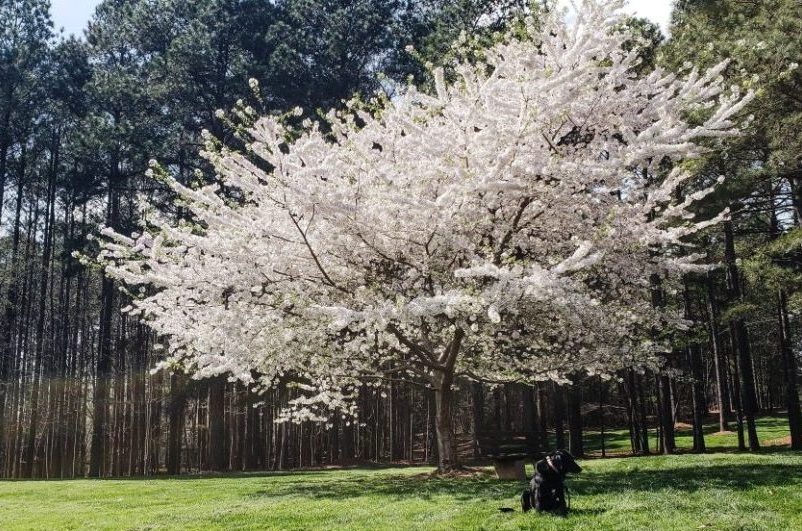
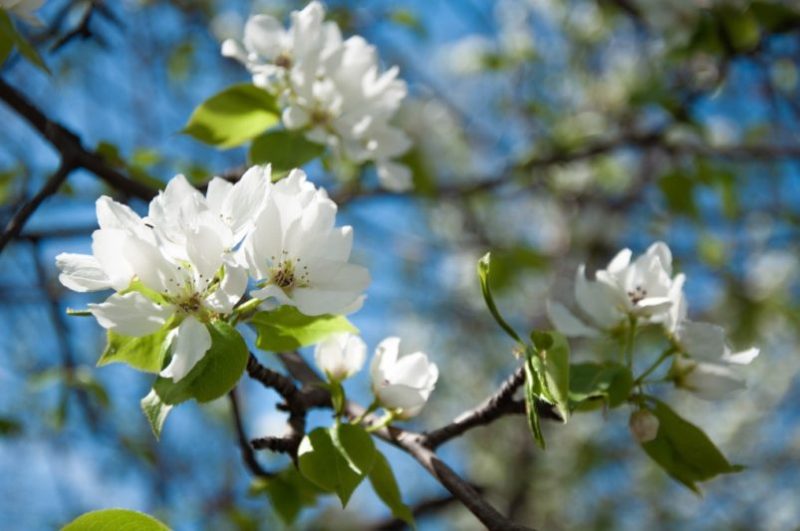
5
EVERGREEN PEAR
Pyrus kawakamii
Native to Taiwan, the evergreen pear is one of San Diego’s standout trees. Is it because it produces a vibrant colorful display of flowers like other trees on this list? No. Does it have delectable juicy pears to eat? No, again. So what’s so special about the evergreen pear? While this tree doesn’t boast of colorful springtime blooms or delicious fruit to eat, it “sticks out of the crowd” due to its distinct flowering season. In the winter, when other trees, like the jacaranda and palo verde, are plain and bare, the evergreen pear showcases its large clusters of white blossoms. It’s a wintry display that’s very appropriate to the season. We may not get snow in the streets of Downtown San Diego or our famous Balboa Park, but we get snow-white laden trees!
The evergreen pear, despite what the name implies, is not an evergreen. It is called an evergreen tree because it has a very short dormant period, causing some people to label it semi-deciduous. In the fall, its foliage morphs to an orangish-red, which drops shortly afterward. Fortunately, it only stays bare for a short period because soon afterward, its canopy becomes engulfed in showy white blooms through the rest of the cold winter season. Then at the end of winter or stretching into spring, the flowers fall to the ground and create a lovely frosty carpet.
The evergreen pear tree — despite its name — does not produce sweet pears for people to eat. Instead, it grows little, brown, inedible fruit that can create a messy nuisance during drop season.
So to sum it up — the evergreen pear is not an evergreen tree, and it doesn’t produce edible pears. Evergreen pear. Just a bit of a misnomer…just a tad.
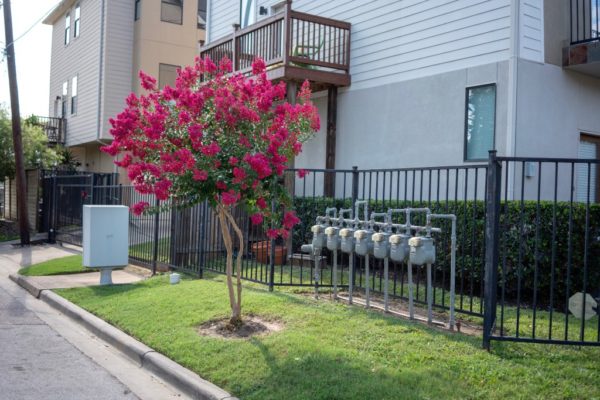
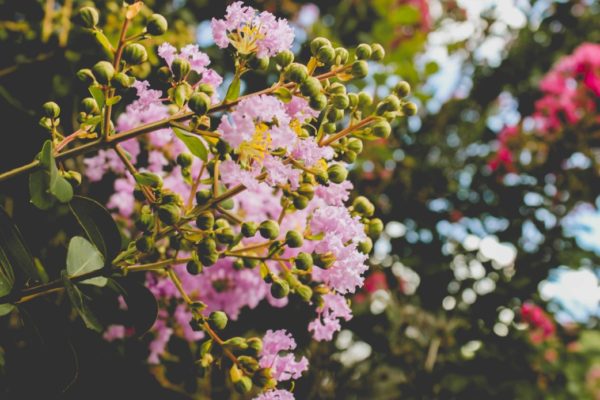
6
CRAPE MYRTLE
Lagerstroemia
The crape myrtle tree, also spelled crepe mrytle, is one of San Diego’s most beautiful flowering trees. It’s a dainty little thing that can be found in different varieties with differing height potentials. It ranges from the “very dwarf” varieties that only mature to a range of 1-3 feet to the regular-sized crape myrtles that “soar” to 20 feet. Then there are the varieties in between — dwarfs, semidwarfs, and small. Crape myrtle trees possess colorful flower clusters available in red, pink, lavender, purple, or white. These fragrant flowers grow in puffy clusters that end up dominating the tree’s canopy in the summer and create beautiful displays in San Diego’s landscape.
The crape mystle’s origins take root in China, where it was named “Pai Jih Hung” — meaning hundred days red. Why? Because the crape myrtle has an amazingly long flowering season that lasts 3-4 months! Quite impressive when you consider that the jacaranda tree’s bloom season lasts 2 months, and the magnolia’s flowers appear for a whopping 7-9 days! While the tree was originally named after its long bloom season, here in the United States, it derived its name from the crinkly appearance of its flowers, which resemble crepe paper.
Aside from its stunning display, the crape myrtle has other features that make it a great tree to add to your property. It is unfazed by the hot summer days and drought conditions. But make sure not to test your crape myrtles heat and drought endurance until its roots are well-established. This tree loves the sun, so also make sure to plant it in an area that receives plenty of sunshine. Otherwise, you may have to miss out on its colorful blooms, as it may not produce flowers if it doesn’t receive enough direct sunlight.
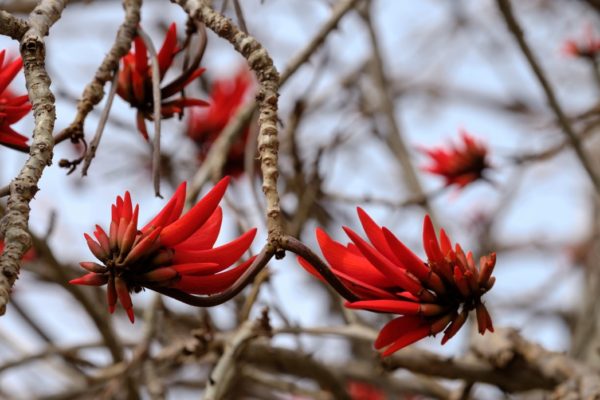
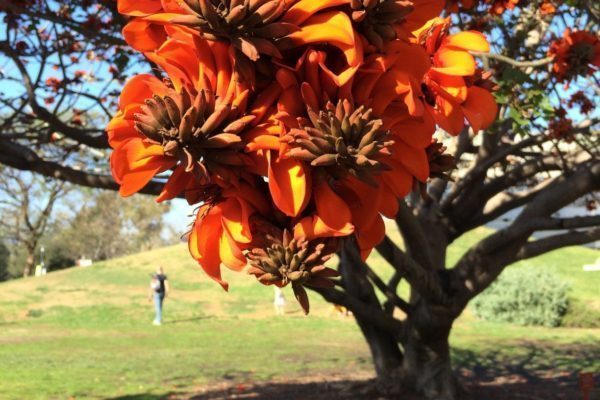
7
CORAL TREE
Erythrina
This next tree shares a striking resemblance to ocean corals. We’re talking about the coral tree, of course — a common and fitting sight for beach-loving San Diego. With roughly 130 species of coral trees (Erythrina), this is a popular tree, not just in California, but in temperate, subtropical, and tropical zones worldwide. It even happens to be the national flower of Argentina and Uruguay.
While many coral trees love the tropical heat (as you can see from their places of origin), quite a few do well in San Diego’s semi-arid climate. About a dozen Erythrina species call San Diego home. These include the naked coral from Mexico, the coastal coral and Tambookie thorn coral from Africa, and the Erythrina x sykesii from Australia. And as heat-loving trees, you might have guessed that coral trees require full-sun exposure to thrive, so make sure to plant accordingly, and don’t worry when it gets over 100° outside. Your coral tree is in “sunshine buffet heaven.”
Our local coral trees are distinguishable by their long, thick secondary branches that stem from a SHORT trunk. Some trunks are so short that they seem to barely rise up out of the ground. But just because it posses a short trunk, it doesn’t mean that the rest of the tree stays short, as it has an average height of 20-40 feet and a wide canopy width of 40-60 feet.
When the tree’s branches start at a low point, it looks like the perfect climbing tree for children. But it’s actually deceiving because the coral tree is notorious in the tree service industry for its susceptibility to breakage and tree failure. This is due to its brittle wood, poor structure, and tendency to form included bark, which is basically a weak junction between two limbs that is prone to splitting given the right amount of pressure. So the coral tree is definitely not the tree you would want to build a treehouse in or hang a swing on. Not to mention, some species also have thorns protruding from their trunk and stems.
Now to the flowers. The coral tree’s blooms are in a class of their own. With their fiery-red color and finger-like appearance, the name Erythrina actually stems from the Greek word for red — erythros. Most Erythrina species develop large, red flowers, but some also display deep orange blooms. When most flowering trees in San Diego flaunt white, yellow, or soft hues of pink or purple, the coral tree’s brilliant red makes this tree’s flower presentation an exotic attention-grabber. You can also see its blooms earlier than other trees due to the coral tree’s tendency to display its flowers in the early spring, as opposed to late spring, like most of the other flowering trees in San Diego.
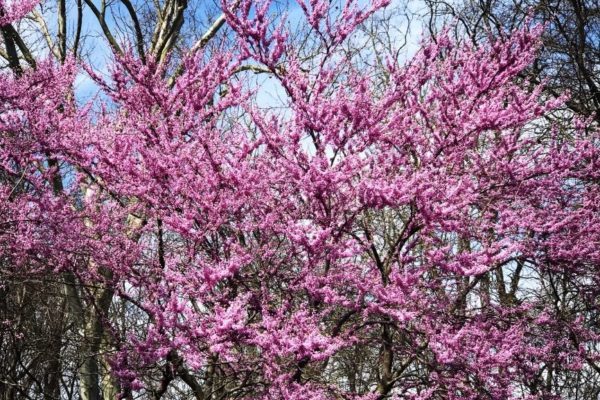
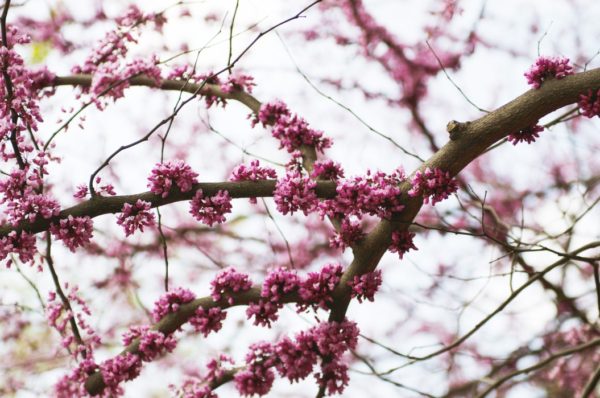
8
WESTERN REDBUD
Cercis occidentalis
Some flowering trees, such as the magnolia and mimosa trees, still retain a good portion of their foliage during bloom season. Other trees become immersed in blooms. The Western redbud is one of those trees. In the spring, hordes of purplish-pink flowers sprout all along the tree’s limbs which last for 2-3 weeks.
There are over 10 redbud species throughout the world, but only two are native to North America. As you may have already guessed, the Western redbud originates from the American Southwest — more specifically from southern Utah, Nevada, Arizona, and California. In fact, it has even been named the California redbud, as it’s a native tree that you can find in canyon bottoms, creeks, and other areas with moister soil in California.
Growing to a height of only 10-20 feet and 10-15 feet wide, the Western or California (whichever name floats your boat) redbud is a great choice for anyone desiring a small tree with pastel-colored blooms. This truly is a springtime tree because unlike many of San Diego’s other flowering trees that hold onto their blooms until summer, the Western redbud typically only possesses its flowers from March to May. It really does scream, “Springtime is here!” with its showy flaunting of pink and purple hues.
The Western redbud is a tree that loves the seasons. In the spring, it bedazzles us with its lovely flowers. Then it drops its blooms to make way for its green, heart-shaped foliage, all ready to soak up the hot sun in the summer. In the fall, the green foliage transforms into comforting autumn colors, which eventually drops toward the end of the year to expose a naked “winter-looking” tree. But be patient, because like clockwork, when the first month of spring comes around, so will those charming blooms!
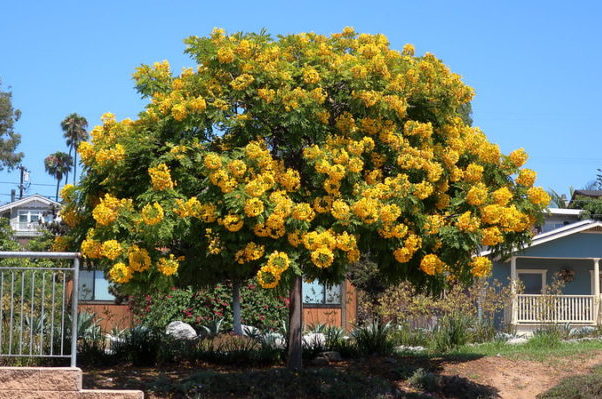
Photo credit: cultivar413

9
GOLD MEDALLION TREE
Cassia leptophylla
The gold medallion tree showcases an explosion of yellow pom-poms during San Diego’s summer months. With its basketball-size flower clusters growing on the ends of its limbs, it truly does look like an explosive fireworks display!
Stemming from Brazil, this is a tropical tree that does best in tropical climates, but still manages to flourish in San Diego’s dry climate. If you’ve visited some of the tropical regions in the United States, the gold medallion probably reminds you of some of the trees from those states. That’s because it has two very popular cousins — the golden shower tree that is so common in the South and the rainbow shower tree that populates the Hawaiian Islands. Both have amazing flower spectacles and so does the gold medallion tree! It’s a family trait.
The gold medallion is a fast-growing tree that sprouts to about 20-25 feet in height, with an average canopy spread of 20-30 feet that is composed of long compound leaves. Being a tropical tree, it does well through San Diego’s heat spells and requires a planting location that receives full sun. After being translated, the gold medallion will require a frequent water schedule until its roots become well-established. Then it will require less water and will tolerate drought conditions very well.
Like other common flowering trees in San Diego, the gold medallion is a member of the legume family, so after the flowers drop, LOOOONG brown seed pods that can grow to about two feet in length begin to take over the canopy. Not too pretty of a sight when you see a populace of brown seed pods dangling from a tree, especially when that tree was looking quite dapper with its green foliage and showy yellow blooms just a few months prior — but beauty is fleeting.
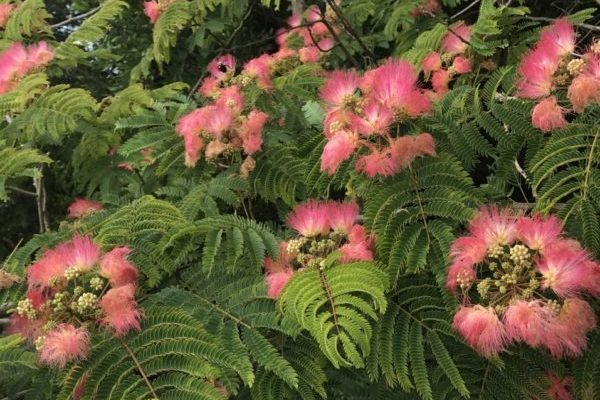
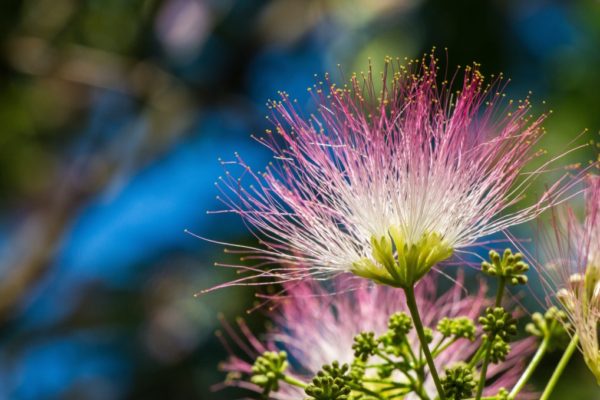
10
Albizia julibrissin
If you like the sight of hummingbirds, then the popular silk tree, also known as the mimosa tree, would make a great addition to your property’s landscape. Hummingbirds, bees, and butterflies absolutely love this tree’s uniquely-shaped, pink blooms. And even better, property owners love this tree for its total package. This is a tree that is not only stunning when it’s in bloom, but it’s also extremely hardy, fast-growing, and easy to care for.
Originating from China, the silk tree was brought to the United States in the mid-18th century, and now can be found in most states from coast to coast. It derived its name, silk tree, from its flower puffs that resemble silk threads. If you have ever traveled to Hawaii, this is a tree that brings a sense of familiarity because it looks nearly identical to its cousin, the monkeypod tree, which reigns as one of Hawaii’s most prominent trees. The silk tree possesses a tropical display and does very well in high temperatures. While it may not be the tropics, it still flourishes in the dry, hot summer months in San Diego. It may be a heat-tolerant and drought-tolerant tree, but being a tropical tree, if you want your mimosa to reach its highest potential, then it would be best to keep it on a regular, deep-water schedule.
In the late spring and into the summer months, the mimosa tree shifts into “bedazzle” mode when its pink blooms emerge. Unfortunately, as the saying goes, “All good things must come to an end.” It holds true with the silk tree. After its beautiful bloom season ends, the tree’s “ugly” season begins, as its gorgeous art show turns into a sad exhibit of 6-inch seed pods. Initially, it’s not too bad, but then the tree’s fern-like foliage drop when the temperatures begin to drop. Then in the winter, all that is left is a straggly, leafless tree with hundreds of drooping, brown seed pods.
As with any tree, when the silk tree is first planted in a new location, it goes through a shock period that can last a couple of years. You won’t see much action during this time. You won’t even see flowers. But once its roots get firmly established (typically 2-5 years), the tree quickly grows until it reaches its plateau height, which typically lands in the 20-30ft range. And after years of waiting, you’ll finally get to see those spectacular flower clusters. But before that happens, the tree needs to reach a certain level of maturity before it can produce flowers. In general, the mimosa typically doesn’t start producing blooms until it reaches a height of 10 feet.
LOCAL SAN DIEGO NURSERIES
Evergreen Nursery
Armstrong Garden Centers
Moon Valley Nurseries

NEED TREE TRIMMING OR REMOVAL SERVICES?
LC TREE SERVICE WOULD BE HAPPY TO HELP!
619.677.5777
The post 10 MOST COMMON FLOWERING TREES IN SAN DIEGO first appeared on San Diego Tree Trimmers – LC Tree Service.